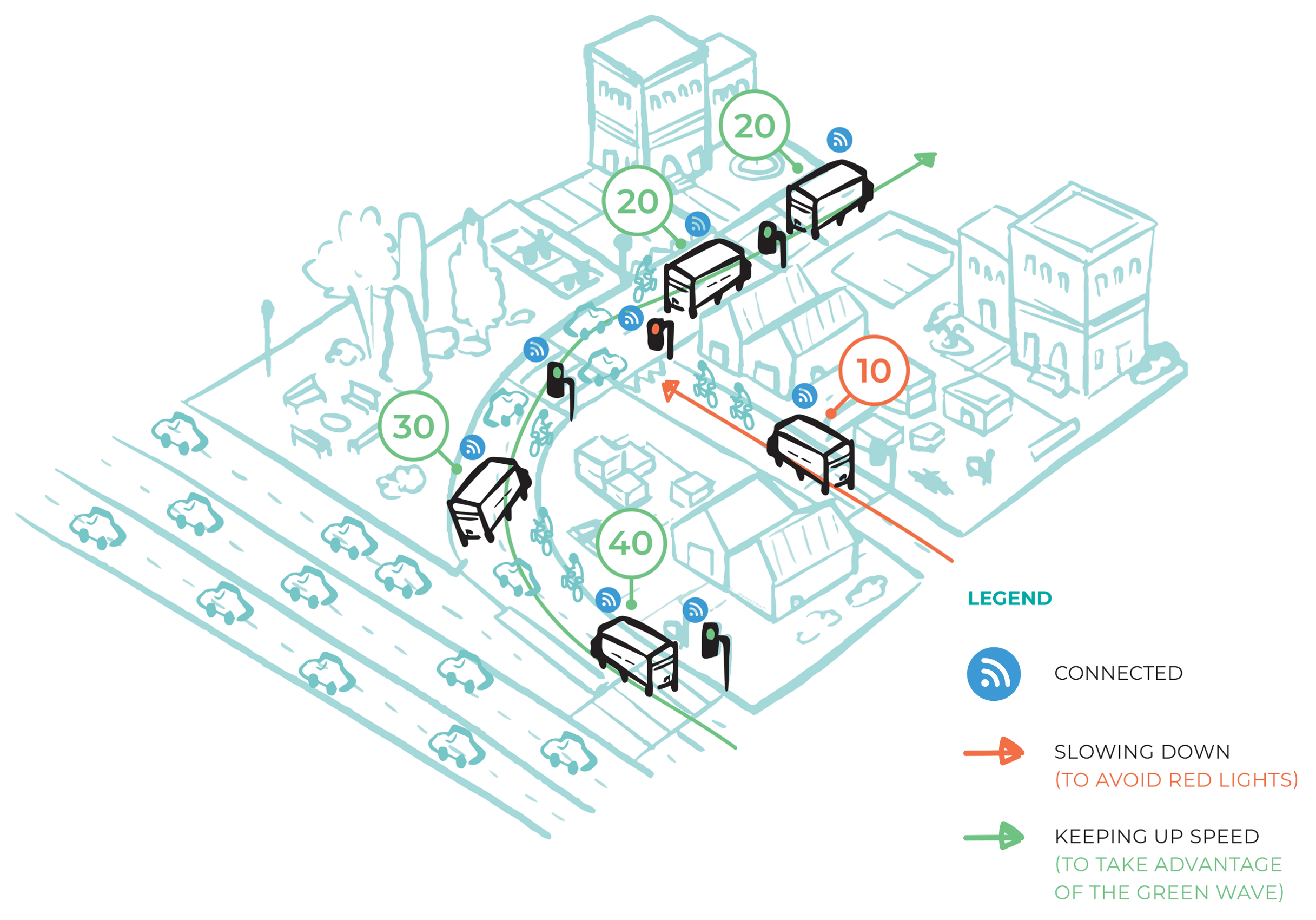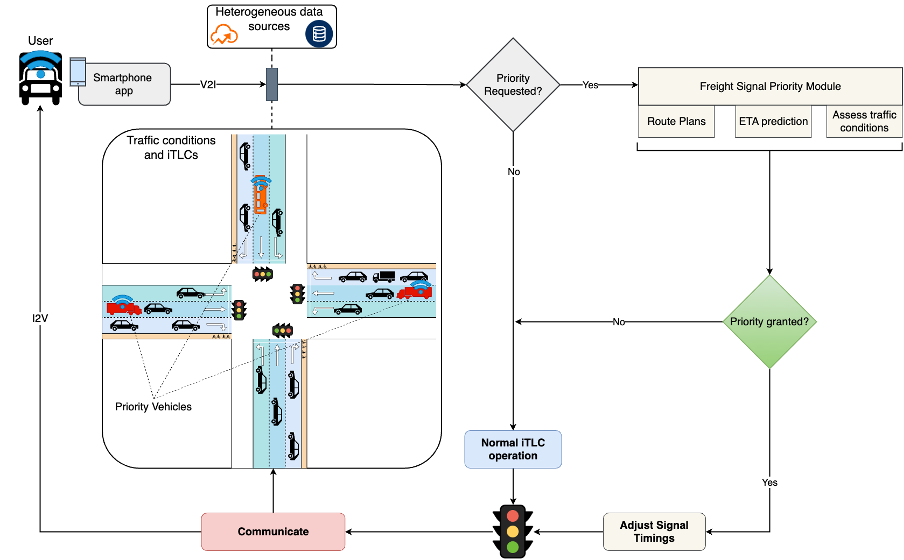UC1 Almelo – Freight Signal Priority for Sustainable Logistics
Description
The city of Almelo, located in the eastern Netherlands, has around 72,000 inhabitants and is home to numerous industries and high-tech firms. As a result, a significant proportion of traffic consists of heavy-duty vehicles such as lorries and trucks. On congested corridors, these vehicles are often forced to stop at signalised intersections, leading to considerable financial and environmental costs in terms of increased fuel consumption, greenhouse gas emissions, and safety risks.
Such stops not only affect freight logistics but also negatively impact wider traffic conditions, as they reduce discharge capacity across the road network. Accumulated local delays can further propagate through route plans, reducing the efficiency and reliability of freight operations.
To address these challenges, the municipality of Almelo has recently deployed intelligent traffic light controllers (iTLCs) equipped with CCAM functionalities. These systems enable safe, effective, and platform-independent communication between infrastructure and vehicles through both vehicle-to-infrastructure (V2I) and infrastructure-to-vehicle (I2V) technologies. By distinguishing between different road user types, iTLCs can tailor traffic management to the needs of specific groups.
Within Almelo’s pathway towards zero-emission logistics, use case 1 (UC1) Almelo focuses on reducing emissions and improving transport efficiency by minimising the number of stops in mixed traffic along a key logistics corridor connecting major roads to local logistics hubs.

Scenarios and Testing
Between June and November 2024, trucks from logistics companies based in and around Almelo were equipped with an ITS application enabling communication with the iTLCs along the city’s ring road. Vehicles approaching intersections could request priority, known as freight signal priority (FSP). Based on prevailing traffic conditions, the iTLCs assessed whether to grant such requests.
When priority was granted, the vehicle’s estimated time of arrival (ETA) was continuously updated and used to adjust signal phases, enabling uninterrupted progression of freight vehicles.
The UC1 Almelo pilot tested the effectiveness of the CONDUCTOR platform in terms of:
- Vehicle–infrastructure communication, allowing real-time data exchange between trucks and iTLCs.
- Fleet operation optimisation, improving efficiency and reliability for logistics firms.
- Supply and demand balancing, considering both freight and general traffic flows.
- Governance aspects, particularly how to prioritise vehicle types while ensuring fair and safe outcomes for all road users.
-
Logistics and freight transport
- Evaluating the added value for logistics companies, both financial and non-financial.
- Key benefits considered included efficiency (reduced travel times), emissions and costs (fewer stops and smoother flow), and driver experience (more consistent driving patterns).
-
General traffic
- Analysing potential consequences of prioritising freight vehicles for other road users such as car drivers, cyclists, and public transport passengers.
- Considerations included safety, emissions, congestion, and equity of treatment across user groups.
-
Local road authority
- Examining governance challenges such as determining which vehicle types should be prioritised, and under what conditions.
- Balancing system-level efficiency with fairness and user satisfaction formed a key part of the evaluation.
Two main scenarios were compared:
- Scenario 0 – Business as usual: No priority granted to trucks at iTLCs.
- Scenario 1 – Freight signal priority active: FSP enabled, with the service alternated weekly between activation and deactivation.
Key Features
Freight signal priority
Dynamic traffic signal control allowing smoother progression of freight vehicles while mitigating negative externalities.
V2I communication
Real-time bidirectional communication between vehicles and traffic signal controllers.
Multi-criteria, multi-modal traffic management
Balancing the needs of multiple road users and stakeholders through adaptive traffic signal strategies.
Key Performance Indicators
Travel times
Measured for trucks traversing the logistics corridor.
Emissions
Assessment of reductions in greenhouse gas emissions.
Fuel consumption
Evaluation of efficiency improvements for heavy-duty vehicles.
Safety
Monitoring of red-light negations and related risks.
Expected Benefits
- Reduction in the number of stops and travel times for trucks
- Lower waiting times for freight vehicles at intersections
- Limited adverse impacts on other road users, as priority is only granted when traffic conditions allow
- Real-time balancing of stakeholder objectives through V2I-enabled traffic control
Contribution to the CONDUCTOR Project
- Multi-modal traffic management strategies balancing user and system objectives
- ATraffic signal control based on V2I functionalities
- Governance schemes for multi-objective traffic management in mixed traffic environments
Deployment Architecture
This framework illustrates the communication between vehicles and infrastructure, as well as the process of freight signal priority. Vehicles equipped with a smartphone application communicate their speed and position to the infrastructure and may request priority when approaching an iTLC intersection.
- If a priority request is received, the FSP module within the iTLC predicts the estimated time of arrival (ETA), taking into account the vehicle’s route plan and prevailing traffic conditions, such as the queue length on the approaching lane.
- When priority is granted, for example through a green time extension or an early green signal, the iTLC adjusts the signal timings accordingly and communicates the updated information to both the signal controller and the vehicle (via the smartphone application).
- If no request is received, or if a request is not granted, the iTLC continues to operate under standard traffic control conditions.

Figure 1. Communication between vehicles and infrastructure, as well as the process of freight signal priority.
